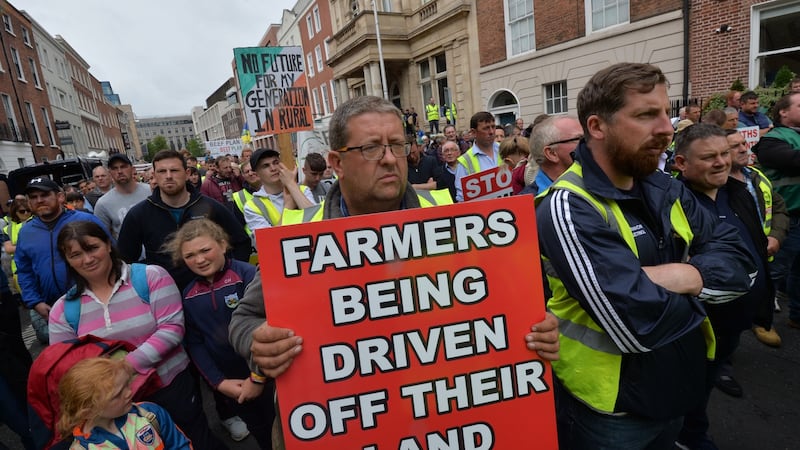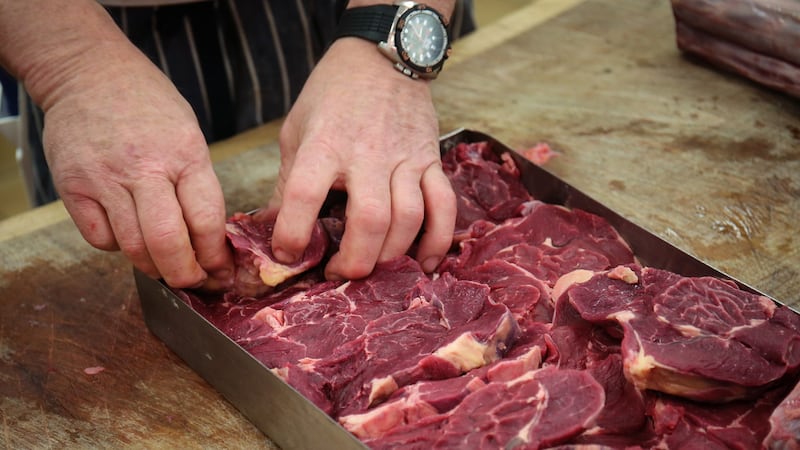The beef protests have led to controversy over the share of the final market price which goes to the farmer. But the roots of farmer unhappiness – and of the difficulties facing the sector – go much deeper.
Rearing beef is now a loss-making business in itself for most farmers, with EU supports needed to move family income from farming into positive territory and off-farm earnings needed to keep afloat.
While some small change on the margin taken by the processor and farmers and how this is arranged may at some stage end the current impasse, the underlying reason for low returns to beef farmers and the questions facing all involved are much more fundamental. Brexit – and the climate change change debate – mean these need to be faced.
1. The background
Incomes on cattle farms have been low for many years and are now under further pressure. Teagasc data shows that there are around 55,000 cattle farms in the country. Just under 26,000 are classified as cattle rearing – suckler production – with the remaining 28.000 engaged in cattle finishing – fattening farms – buying cattle from other farms and then selling them on to processors.
Income levels from these enterprises are strikingly low. The Teagasc figures for 2018 show that family income from farming on cattle rearing farms was just €8,301 on average.with a dramatic increase in farms reporting incomes of less than €5,000 which now represent 44 per cent of the total. Two thirds of farms earned less than €10,000.
These figures includes direct payments from the EU which average €13,098 per farm for 2018. The average suckler farm with a family income from farming of €8,311 lost €4,700 of the direct payments in their farming business. Beef farming in itself is a loss-making business . Before supports, most farms are in the red. The majority work off farm to boost their incomes.
The income figures on the cattle-finishing farms are a bit higher, but still very low and they are also – on average – loss-making before direct payments are counted in.
Here average family income from farming is €14,560, counting in average direct payments of €16,226. Average farm and herd size is a bit bigger than the suckler farms, but just under half of these farms earned less than €10,00 from farming in 2018, counting in the direct payments.
This economic picture is not unique to Ireland, with beef farmers across Europe losing money or making wafer-thin margins before support payments, even though the EU beef market is part-protected from low-cost international competition.
So we have a lot of relatively small farms earning low returns, way below dairy, where average farming income was over €61,000 and tillage, around €40,600. With beef prices falling sharply again this year, partly due to uncertainty about future exports orders in the UK due to Brexit pressure, is rising.
Add in the Mercusor deal proposing greater access for South American beef – even though it will not change market conditions for some years, if ever – and a recommendation from the Climate Change Council, which advises the Government, that beef farmers should be incentivised to move into other areas and it is perhaps no surprise that tensions are running high.

2. The money split
In assessing the issues in the debate between farmers and processors, we run into one immediate problem. We know what farmers are paid for cattle – and that this price in cash terms has not increased for a long period. And we know what consumers pay in Ireland, or – roughly – the price of exports. These prices have also remained stuck – you don’t pay much more for your meat than you did in the late 1990s, in cash terms.
But we don't know what prices are paid in the intermediate stage as beef moves from processor to retailer. The IFA, which has engaged economist Jim Power to look at the issue, has gone as far as calling for a commission of investigation to examine this, given the lack of available data.
So what do we know? Prices to farmers vary depending on the type of cattle involved and factors such as their age – and the rules for calculating this and qualifying for a slightly higher price are part of the debate between processors and farmers.
An average price for steer beef has fallen this year – to around €3.50 per kg in many cases. With sirloin beef often selling at €9 to €10 a kg in Irish supermarket chains, farmers have claimed they are not getting a fair share. But you can’t compare the two figures directly as the processor sells different cuts at different prices and gets a variety of yields.
The farmers say they get €2 for every €10 the Irish consumer spends, while the industry contends it is over €6.
Perhaps the truth lies in the middle. Figures from France, where there is greater transparency, suggest that farmers get around 45 per cent of the retail price. Notably, the data, presented at an EU seminar last year, showed that this still left farmers facing small losses before EU payments were counted in, processors making small margins of 1 per cent or less and supermarkets appearing to use meat as a loss-leader product. This sounds similar to the Irish industry structure.
The low and static market price for beef, both in EU markets and here, has gradually squeezed the industry. Looking at export data and prices would suggest that the share for farmers from the price paid in foreign markets is closer to the industry figure than the farmers' estimate, though we simply don't have enough data to give a definitive figure. And in any case what farmers are getting at the moment is not enough to make a profit on their basic businss before EU payments.
Here domestic consumption is not the key driver of returns to farmers, as 90 per cent of output from the sector is exported, with the UK by far the single biggest market."The value of export sales from Ireland - that is prices on Irish beef export markets - is the principal determinant of Irish cattle prices,"according to Kevin Hanrahan, Teagasc research officer.
“Local supply conditions in Ireland can in the short run affect the price relativity between cattle prices in Ireland and on our export markets but all the economic evidence points to Irish prices being determined by EU prices.”
So price is dictated by the markets into which we sell – and higher prices would likely lead to lower demand. Farmers and processors are arguing over who gets the split – a legitimate row – but the size of the cake they are fighting over is set by international trends.
So, is the industry profiteering? Beef processing is a high volume, low margin business, again, according to Hanrahan, in line with the international picture in the industry.
There was comment recently on the €3.12 million annual profit made by the holding company which owns Slaney Meats and Irish Country Meats, owned by Larry Goodman's ABP and Linden Foods from Northern Ireland. However this was on turnover of €340 million, a bottom line profit of less than 1 per cent of sales. Agrifood economist Ciarán Fitzgerald estimates that the sector, with a €2.65 billion turnover, has annual gross profits of around €94 million and net profits of €20 million to €30 million , or 0.7 per cent to 1.2 per cent of sales.
On these margins the industry will not willingly give much more to farmers, particularly as a no-deal Brexit threatens to make their key export market , the UK, into a very difficult proposition leading to major pressure on both sales and margins.

3. The key policy issues
The small average size of farm holdings and low returns have long characterised the beef sector. The small scale of farm producers here also means that costs of production are well above the EU average.
Farmers would argue that quality is too. Ireland may also be able to make a case in terms of the carbon efficiency of production here – which EU data suggests puts is as one of the more efficient in the EU. This is a controversial area in terms of measurement and we are likely to hear a lot more about this in the years ahead.
Beyond hoping that the immediate issue between processors and farmers is solved, there are real issues here for the Government, now coming to the boil due to Brexit and the climate debate.
Many farm families may be doing OK when off farm income is added, but falling prices have cut incomes at a time when incomes elsewhere in the economy are on the rise and left some in trouble. And now Brexit – particular a no-deal Brexit – threatens a massive further hit, with Irish beef likely to be subject to heavy tariffs, or taxes, in the UK market.
In turn, this potentially creates a further sharp fall in income for beef farmers and the need for an urgent Government support programme for the industry.
And then there is the climate change agenda. The Climate Change Advisory Council has said the Government should target a reduction of 53 per cent in the suckler herd in the years ahead, encouraging farmers to move into other potentially more profitable areas like woodland and biomass. Not surprisingly this has proved controversial.
The combination of Brexit, the economic crisis among beef farmers and the climate change agenda poses some fundamental choices.
Do we try to increase efficiency by moving to bigger farm units and if so how? Or do we aim to reduce the size of the national herd? And in either case what are the future of EU payments, which presumably will be linked in future to the climate change agenda?
Everyone knows that divvying up the money differently between processors and farmers will only paper over the cracks. And the €100 million fund for cattle being paid for half and half by Irish and EU taxpayers is just a stopgap.
Brexit has underlined the fundamental issues facing the sector and, if a no-deal happens, will lead to some very uncomfortable decisions for the Government about just what a viable Irish beef industry might look like.









